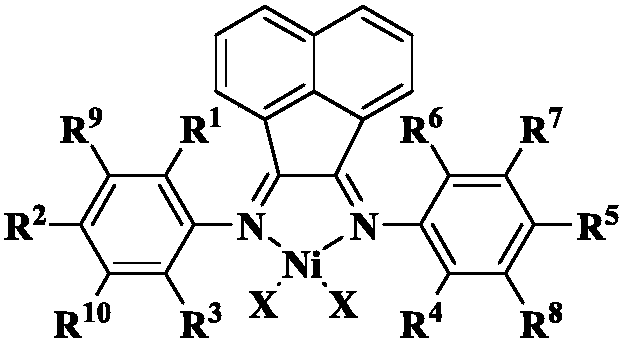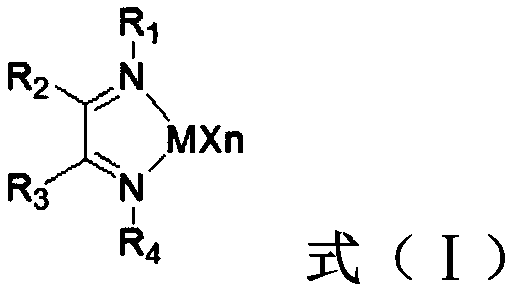Catalytic system for olefin- olefin alcohol polymerization, olefin-olefin alcohol copolymerization method and polymer
A catalytic system and olefin alcohol technology, applied in the field of polymers, can solve the problems of large amount of catalyst dosage of methylaluminoxane, influence of catalyst polymerization activity, etc., and achieve broad industrial application prospects, narrow molecular weight distribution, and good thermal stability. Effect
- Summary
- Abstract
- Description
- Claims
- Application Information
AI Technical Summary
Problems solved by technology
Method used
Image
Examples
Embodiment 1
[0088] Dry the 1L stainless steel polymerization kettle equipped with mechanical stirring at 130 ° C for 6 hours, vacuumize while it is hot and use N 2 Air replacement 3 times. Inject 500 mL of hexane into the polymerization system, while adding 1.6 mg (2.5 μmol) of complex a, 3 mL of 10-undecen-1-ol, 15 mL of AlEt 3 (1.0 mol / L hexane solution), 3 mL of methylaluminoxane (MAO) (1.53 mol / L toluene solution), at 30°C, maintain 10 atm ethylene pressure, and stir for 30 min. Finally, it was neutralized with an ethanol solution acidified with 5 volume % hydrochloric acid to obtain a polymer. The polymerization activity and the performance parameters of the polymer are shown in Table 1.
Embodiment 2
[0090] Dry the 1L stainless steel polymerization kettle equipped with mechanical stirring at 130 ° C for 6 hours, vacuumize while it is hot and use N 2 Air replacement 3 times. Inject 500 mL of hexane into the polymerization system, and simultaneously add 1.6 mg (2.5 μmol) of complex a, 6 mL of 10-undecen-1-ol, 30 mL of AlEt 3 (1.0 mol / L hexane solution), 3 mL of methylaluminoxane (MAO) (1.53 mol / L toluene solution), at 30°C, maintain 10 atm ethylene pressure, and stir for 30 min. Finally, it was neutralized with an ethanol solution acidified with 5 volume % hydrochloric acid to obtain a polymer. The polymerization activity and the performance parameters of the polymer are shown in Table 1.
Embodiment 3
[0092] Dry the 1L stainless steel polymerization kettle equipped with mechanical stirring at 130 ° C for 6 hours, vacuumize while it is hot and use N 2 Air replacement 3 times. Inject 500 mL of hexane into the polymerization system, and simultaneously add 1.6 mg (2.5 μmol) of complex a, 6 mL of 10-undecen-1-ol, 30 mL of AlEt 3 (1.0 mol / L hexane solution), 3mL methylaluminoxane (MAO) (1.53 mol / L toluene solution), at 60°C, maintain 10atm ethylene pressure, and stir for 30min. Finally, it was neutralized with an ethanol solution acidified with 5 volume % hydrochloric acid to obtain a polymer. The polymerization activity and the performance parameters of the polymer are shown in Table 1.
PUM
| Property | Measurement | Unit |
|---|---|---|
| melting point | aaaaa | aaaaa |
| density | aaaaa | aaaaa |
| melting point | aaaaa | aaaaa |
Abstract
Description
Claims
Application Information
 Login to View More
Login to View More - R&D
- Intellectual Property
- Life Sciences
- Materials
- Tech Scout
- Unparalleled Data Quality
- Higher Quality Content
- 60% Fewer Hallucinations
Browse by: Latest US Patents, China's latest patents, Technical Efficacy Thesaurus, Application Domain, Technology Topic, Popular Technical Reports.
© 2025 PatSnap. All rights reserved.Legal|Privacy policy|Modern Slavery Act Transparency Statement|Sitemap|About US| Contact US: help@patsnap.com



